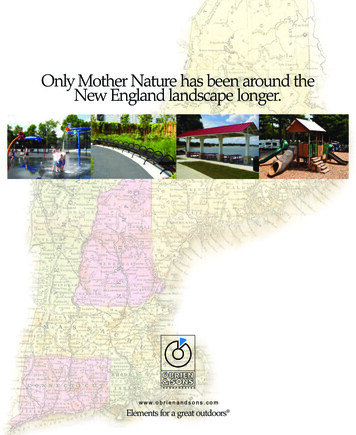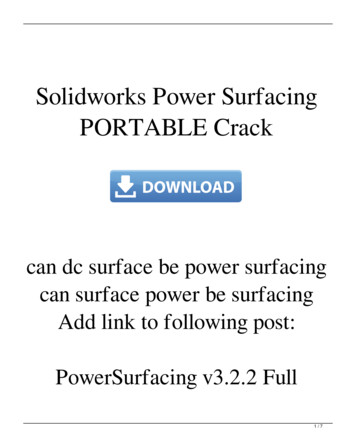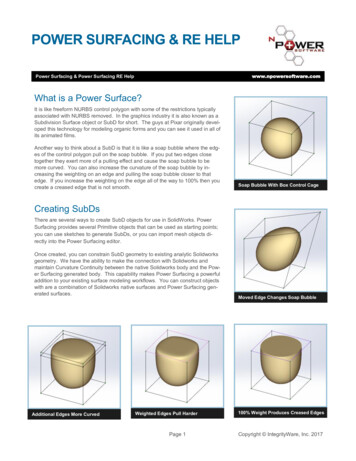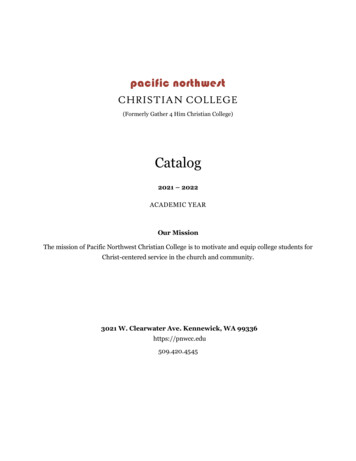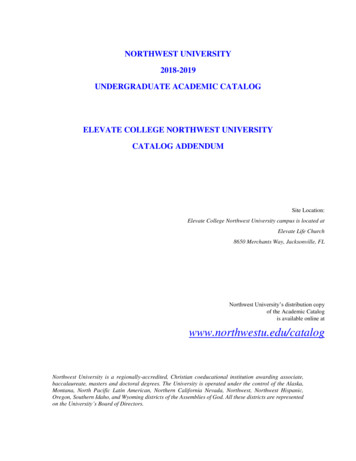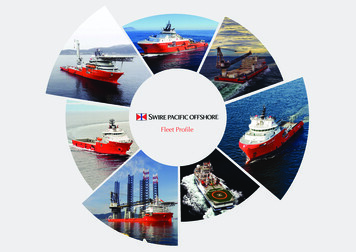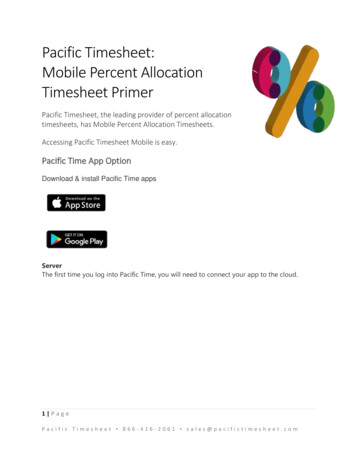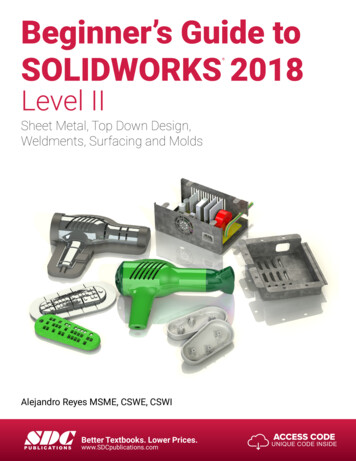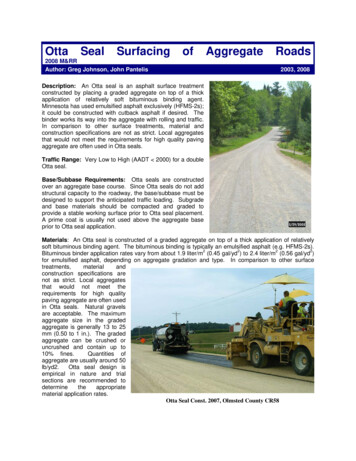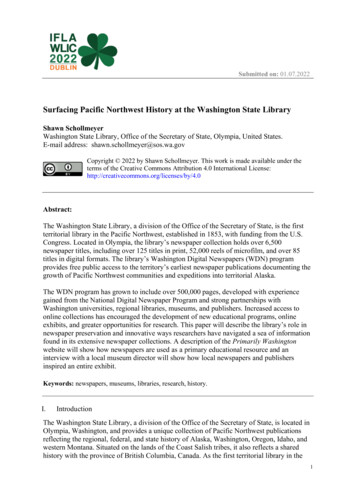
Transcription
Submitted on: 01.07.2022Surfacing Pacific Northwest History at the Washington State LibraryShawn SchollmeyerWashington State Library, Office of the Secretary of State, Olympia, United States.E-mail address: shawn.schollmeyer@sos.wa.govCopyright 2022 by Shawn Schollmeyer. This work is made available under theterms of the Creative Commons Attribution 4.0 International Abstract:The Washington State Library, a division of the Office of the Secretary of State, is the firstterritorial library in the Pacific Northwest, established in 1853, with funding from the U.S.Congress. Located in Olympia, the library’s newspaper collection holds over 6,500newspaper titles, including over 125 titles in print, 52,000 reels of microfilm, and over 85titles in digital formats. The library’s Washington Digital Newspapers (WDN) programprovides free public access to the territory’s earliest newspaper publications documenting thegrowth of Pacific Northwest communities and expeditions into territorial Alaska.The WDN program has grown to include over 500,000 pages, developed with experiencegained from the National Digital Newspaper Program and strong partnerships withWashington universities, regional libraries, museums, and publishers. Increased access toonline collections has encouraged the development of new educational programs, onlineexhibits, and greater opportunities for research. This paper will describe the library’s role innewspaper preservation and innovative ways researchers have navigated a sea of informationfound in its extensive newspaper collections. A description of the Primarily Washingtonwebsite will show how newspapers are used as a primary educational resource and aninterview with a local museum director will show how local newspapers and publishersinspired an entire exhibit.Keywords: newspapers, museums, libraries, research, history.I.IntroductionThe Washington State Library, a division of the Office of the Secretary of State, is located inOlympia, Washington, and provides a unique collection of Pacific Northwest publicationsreflecting the regional, federal, and state history of Alaska, Washington, Oregon, Idaho, andwestern Montana. Situated on the lands of the Coast Salish tribes, it also reflects a sharedhistory with the province of British Columbia, Canada. As the first territorial library in the1
region, established in 1853, it holds early expedition charts, legal resources required forterritorial government, and primary documentation of Native American tribal agreements. Itis a repository for federal and state publications covering a variety of subjects, which areimportant resources for state employees and legislators as well as researchers, genealogists,and enthusiastic readers of regional fiction and non-fiction.II.The Washington TerritoryThe Pacific Northwest region of North America spans the western province of BritishColumbia in Canada and the states of Alaska, Washington, and Oregon in the United States.These jurisdictions share the coastline of the Pacific Ocean. With the exception of Alaska,they also share the Cascade Range with some of the tallest mountains on the continent. Theearliest inhabitants of these lands are descended from more than 50 nations of Coast Salishpeople whose ancestors have lived there since time immemorial. They know the PacificOcean as the Salish Sea and their land extends from lower British Columbia down to themouth of the great Columbia and Willamette Rivers in Oregon. We gratefully acknowledgethe sacrifice the Salish peoples and their contributions to the land upon which the WashingtonState Library is located.The abundance of marine life and evergreen forests drew many European settlers to theregion in the mid-1800s. Settlers from Sweden, Norway, France, England, and Germanycame out for the fishing and timber industries. Soon rumors of the gold rush in Alaska andBritish Columbia drove fortune seekers from across North America and China to pick upsupplies in Seattle and head north. As communities grew, the need for railroads, timber, andminerals drove economic growth and brought immigrants from China, Croatia, Ireland,Japan, and the Philippines to find new opportunities.As the population grew, bankers, land developers, politicians, and publishers also came to thePacific Northwest to influence economic progress, infrastructure development, and voicetheir opinions in their desire for self-government. Many editors and publishers in the mid-tolate 1800s were advocates for statehood and active voices in economic development.Throughout the decades, these advocates provided essential services for their communities.Legal notices, election results, land claims, vital statistics were not available elsewhere to theaverage citizen and these “newspapers of record” were the only way to advertise localbusinesses, events and social activities. Today, these same newspapers have become essentialinformation for different reasons, linking past events and people to the understanding of ourown heritage and present environment.III.WSL’s Role in Newspaper PreservationIn 2022, the Washington State Library continues its role as historic record keeper under theRevised Code of Washington, RCW 27.04.045(8). This legal mandate requires the statelibrarian and staff to preserve community newspapers of record across the state “Serving asthe depository for newspapers published in the state of Washington thus providing a centrallocation for a valuable historical record for scholarly, personal, and commercial reference andcirculation.” The library maintains subscriptions to as many newspapers across the state asbudget allows, keeping print issues for approximately 10 years before preserving issues onmicrofilm. The physical newspaper collection includes over 6,500 newspaper titles and morethan 52,000 reels of microfilm, which makes it one of the largest collections of Washingtonnewspapers in the state. In the early 1990s, the U.S. Newspaper Program (USNP), inpartnership with the National Endowment for the Humanities (NEH) and the Library of2
Congress (LoC), provided funding for microfilm preservation of at-risk newspapers. Masternegatives created for the program are stored offsite at its sister agency, the Washington StateArchives.In 2005, the library began a digital newspaper program with focus on the earliest publicationsfrom the Washington territorial period. In 2008, the library was awarded the first of fourNational Digital Newspaper Program (NDNP) grants, also funded in partnership with NEHand LoC. Through this digitization program, the library contributed over 400,000 pages ofhistoric newspapers, with standardized metadata, to the Chronicling America website.Starting in 2015, the Washington Digital Newspapers (WDN) program shifted to meet theneeds of regional museums and historical organizations by using the experience andstandards learned from NDNP. A newspaper preservation and digitization consulting serviceprovides assistance to libraries, museums, and other heritage organizations under the LibraryServices and Technology Act (LSTA), funded by the Institute of Museum and LibraryServices (IMLS). Libraries and museum organizations who wish to digitize their communitypaper receive free consulting and hosting services, with guidance on copyright issues,digitization, and preservation standards. In 2019, WDN implemented a new hosting platform,using Veridian software created by DL Consulting specifically for newspapers. The newwebsite provides a stable hosting service and is easy for users to view pages and performsimple keyword and full-text search of the newspapers. The new site also improvesaccessibility and can easily hold the online collection, which has surpassed over half amillion pages in 2022.To prepare for a new production workflow and the collection of born digital content, a newlong-term Microsoft Azure cloud storage system will be installed in 2022. A recentagreement with Newspapers.com will double production and allow WDN staff to respond toincreasing requests for digitization and create new outreach programs. The larger storagespace will allow WDN to develop intermediate and long-term workflows to hold restrictedcontent before it can be released for upload to the public website and protect the collectionfor disaster recovery.IV.Navigating an Ocean of Newspapers In Person and OnlineVisitors to the library can access newspaper microfilm reels in the library’s Reading Room inOlympia or by requesting the film through interlibrary loan to view at their regional library.Many visitors travel from out of state to search family history and use the on-site newspaperdatabases by appointment. A few, frequently requested titles, such as the capital city’sOlympian newspaper have been indexed so that specific articles can be requested through thelibrary’s AskALibrarian program if specific dates, event, or person names are known.Since August of 2021, when the facility re-opened with COVID-19 safety measures in place,nearly 600 visitors have returned to the Reading Room for research. Approximately twothirds of these visitors are estimated to be using microfilm resources at the library.Newspaper microfilm statistics from July 1, 2021 through June 15, 2022 indicate that therewere over 1,100 requests for newspapers on microfilm by in-house customers, staff, andthrough Ask-A-Librarian chat forums. At least 278 reels were shared to libraries viaInterlibrary Loan services.3
The library subscribes to 125 daily and weekly print newspapers that can be viewed in theReading Room. There are 12 online databases exclusive to state library cardholders. Librarycards are freely available to Washington State residents, but visitors can also access thesedatabases free in the Reading Room. The library maintains a list of current newspaperwebsites and six indexes to Pacific Northwest newspapers.Genealogists are frequent visitors to the Reading Room and many researchers travel fromCalifornia, Idaho, and beyond. COVID-19 public health concerns prevented genealogistsfrom visiting for a few months, but groups such as the Sons of Norway or Daughters of theAmerican Revolution are back to trace their roots through the newspapers on microfilm oncethe building re-opened. Occasionally journalists and lobbyists stop to research the provenanceof a state regulation or the history of a bill. Contextual information is not contained in the“Legislative Digest and History of Bills of the Senate and House of Representatives,” alsoknown as the “Bill Books.” Recent editions of these “Bill Books” are now online, but theoldest editions are only available in print. Reference librarians will regularly directresearchers to the historic newspapers to find information about the primary supporters andthe passage of bills submitted in the late 19th and early 20th centuries.The library regularly hosts several historians who use the physical and online newspapercollections to write history publications on a variety of subjects. One such researcher isJennifer Crooks, who has written articles for online publications such as Thurston Talk, aThurston County oriented news & activity website that regularly features articles on localhistory. She has also given lectures and written the book “Washington State CapitolCampus.” In her recent 2022 article “Read All About It: May Munyan and Dupont’s [SIC]First Newspaper “The Villager,” Crooks describes the life of May Munyan, editor of the firstnewspaper in the small town of DuPont, Washington. Crooks holds a bachelor’s and master’sdegree in American history and can frequently be seen in the Reading Room researchingalongside her father, Drew Crooks, also an historian and author.4
V.Surfacing Primary Resources to Meet User needsThe Primarily Washington website is a collaboration between the Washington State Archives,Legacy Washington, and the Washington State Library to share primary resources from theirrespective collections with K-12 educators and history enthusiasts. It was designed as aneducational portal for teachers and students to freely access lesson plans and study guides,regardless of their enrollment in public, private or home school programs to meet WashingtonState social studies requirements. The open source Omeka database and publishing platformcontain digitized maps, books, photos, and newspaper articles. Library staff worked withlocal educators to design easy-to-use digital “packages” that focus on specific subjects ofstate history and meet educational requirements in Washington’s K-12 school system.A chart of lesson plans and grade levels guides teachers to the appropriate plans for theirstudents, which link directly to the learning plans, activities, and objectives for classroomdiscussion. Students can browse collections of primary resources, browse curated exhibits, orreview a list of newspaper articles on the “Newspaper - Moments in History” tab. This list ofevents and references links to newspaper articles selected to engage students in furtherdiscussion on topics and perspectives of the time-period. Many of the articles show insight todifficult topics and the strained relationships of the territorial era, pointing to the conflictsbetween native peoples, immigrants, and settlers. Connections between past events andtoday’s issues can be discussed in the context of immigration, women’s suffrage, nativerights, and early statehood, among other subjects.5
VI. Anacortes Museum’s Online ExhibitThe city of Anacortes is a small maritime community along the north coast of the PugetSound. It is an essential port for the international ferry crossing between the U.S. andVictoria, British Columbia, as well as primary access to Washington’s San Juan Islandcommunities. The Anacortes American newspaper, established in 1890, frequently reportedon the community’s Scandinavian heritage, fishing, and agriculture activities.The City of Anacortes Museum maintains physical collections of artifacts and historic objectsto show the lifestyles of settlers and native peoples. It holds a collection of nautical charts,maps, and a photograph collection of over 50,000 prints. It also contains the Wallie Funkphoto collection of over 100,000 photos, documenting the city’s history from the 1880sthrough the 2002. These photos were collected by Wallie Funk, publisher of the AnacortesAmerican newspaper from 1950-1964, to preserve the history of his hometown. The museumalso tracks a number oral histories, films, memorial sites, and murals, sharing the localhistory with the public through in-person and interactive exhibits to highlight thecommunity’s heritage.In 2016, museum staff reached out to the Washington State Library inquiring aboutdigitization practices for their extensive Anacortes American print newspaper collection.With the support of the current publisher of the newspaper, the library began work to digitizenearly 70,000 newspaper pages for public access via the WDN website. The project isnearing completion and will be finalized by the end of 2022.In an interview with Museum Director, Bret Lunsford, about the use of newspapers in theirdaily work, he described newspapers as a “super-power” in their search for historic content.He addressed the convenience of accessing newspapers online and compared past efforts toseeking a “needle in a haystack.” “It's a place that I turn to with a lot of trust” though heacknowledges that there may be bias in the articles, he can learn the context of events thathad occurred in the past and verify the related names of people and places. He would find thatsometimes a story would “ripple out” into another publication, and, by living in a city with aunique name like Anacortes, more information on a person or event can easily be found.The museum staff use the online WDN collection daily to identify and catalog subjects intheir photo database. People, place names, dates, and related events that previously had littleto no information can be searched to find the additional metadata needed to enrich their owncollection. The staff, and members of the public, can also use a “text correction” feature onthe WDN site where they can correct sections of text results missed or misinterpreted by theOptical Character Recognition (OCR) software used in the digitization process. Thisincreases the accuracy of WDN website search results, so the research and text correctionsbecome a mutual benefit for the museum, library, and future researchers. As a promoter ofthe museum’s activities, Lunsford considers this an opportunity to engage local residents anduse the online newspaper collection as a “first step” to building a community encyclopaedia.In 2019, the museum curated one of its first online exhibits to honor the heritage andinfluence of publishers past and present in the community. Museum curator, Elain Walker,used the WDN collection to research early publications and tell the story of the city’sdevelopment through the stories in the newspapers. Historical notes and contextualinformation were added to a collage of articles and photos, pulling the stories together andnoting how perspectives of the times may be different from present attitudes. At the bottom6
of the exhibit page, “Open Forum” prompts invite readers to engage in discussion by sharingtheir own stories and experiences.From Anacortes Museum Exhibit: “Extra! Extra! The Early Years of Anacortes Newspapers” 2019.The museum also plans to create smartphone mural tours with podcasts and videos to tellvisitors about the numerous murals installed throughout the city blocks. Newspaper researchwill support stories about local artist, Bill Mitchell, who created over 150 painted muralsdepicting prominent citizens of the past. These podcasts will feature subject biographies,obituaries, and timelines found in newspapers to bring this outdoor exhibit to life.7
VII. Sailing Toward Future OutcomesSince its inception, the WDN program has been a small department of one or two staffmembers primarily focused on the production and upload of content. With the new workflow,some of the burden of production will be lifted to allow staff to focus more on outreach,educational resources, and consulting. Through the exhibits and discussions with theAnacortes Museum and Primarily Washington educational staff, we are inspired to createnew resources for our newspaper readers and heritage organizations. We look forward to ournext opportunities to promote our newspaper collections and share the creative ways peopleare already using them. New tools with augmented reality, history tours on mobile devicesand podcasts with stories from our early newspapers are a few of the inspirations that wehave received from our newspaper researchers. These we will share with our colleagues inlibraries, museums and research.New projects will also encourage participation by library and information school students toutilize newspaper data in their capstone and directed fieldwork projects. The volume ofnewspaper content provides unique opportunities to study topical data across the state in theareas of Diversity, Equity, and Inclusion (DEI), image identification and search and languageusage among other endless opportunities based on student interest.AcknowledgmentsThe author would like to thank City of Anacortes Museum Director, Bret Lunsford, andHistorian Jennifer Crooks for providing their time for interviews. Washington StateLibrarians, Judy Pitchford and Mary Schaff, Tien Triggs and Cathy Banta for providinglibrary usage statistics.The Washington Digital Newspaper program would not be possible without the federal grantopportunities from the National Endowment for the Humanities, the Institute of Museum andLibrary Services, or the guidance of the Library of Congress NDNP staff.References1. RCW 27.04.045(8) Duties of state librarian. Washington State x?cite 27.04.0452. Crooks, Jennifer. ial-narrative-of-our-capitols-history/3. Crooks, Jennifer. “Read All About It: May Munyan and Dupont’s First Newspaper “The Villager” SouthSoundTalk ewspaper-the-villager/4. Crooks, Jennifer; Crooks, Drew; DuPont Historical Society. DuPont: Images of America. 2019.Arcadia Publishing.5. Muck Rack. https://muckrack.com/jennifer-crooks/articles6. “The Columbian” newspaper essay. Anonymous. Washington Digital /?a cl&cl CL1&sp COLUMBIAN&e -------en-20--1--txttxIN------7. Lunsford, Bret and Anacortes Museum staff. Anacortes Museum Exhibit: “Extra! Extra! The EarlyYears of Anacortes Newspapers.” Newspapers in Anacortes - (2019) (PDF)8. "Wallie Funk Photo Collection.” City of Anacortes Museum. Wallie Funk Collection Anacortes, WA(cityofanacortes.org)9. “Bill Mitchell and the Anacortes Mural Project.” the-Anacortes-Mural-Pr8
The Pacific Northwest region of North America spans the western province of British Columbia in Canada and the states of Alaska, Washington, and Oregon in the United States. These jurisdictions share the coastline of the Pacific Ocean. With the exception of Alaska, they also share the Cascade Range with some of the tallest mountains on the .
